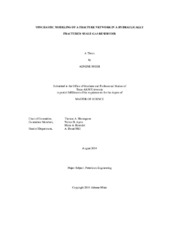| dc.description.abstract | The fundamental behavior of fluid production from shale/ultra-low permeability reservoirs that are produced under a constant wellbore pressure remains difficult to quantify, which is believed to be (at least in part) due to the complexity of the hydraulic fracture patterns created during the well stimulation process. This work introduces a novel approach to model the hydraulic fractures in a shale reservoir using a stochastic method called random-walk. We see this approach as a beginning step that could be used to capture a part of the "complexity" of a fracture that has been generated by a hydraulic fracturing treatment and that such "complex" fracture processes may be observed in the Microseismic measurements.
To assess the random-walk fracture concept, we performed numerical simulation of the patterns generated using a given random-walk fracture pattern. Using a total of 83 pattern cases, sensitivity analyses were performed on these fracture patterns; where the tortuosity, the extent (length), the tendency to split, and the number of branching stages were the factors considered. The rate performance of the "random-walk" fracture cases were compared to the standard model of a (single) planar hydraulic fracture. In addition to the mass rate performance, the created pressure distribution was analyzed in "time slices" (or "snapshots) to qualitatively assess each complex-pattern during early production times (before the onset of the pseudosteady-state flow regime).
Our results were used to create a correlation between fracture performance, in terms of cumulative recovery, and the fracture volume and "complexity." In addition, an empirical correlation between the number of stages of bifurcation (splitting) of the fracture pattern and the value of the mass rate β-derivative for early production times was then established. Finally, as we were limited to a small-scale case due to the intensive gridding required, the feasibility and the advantages of a full-scale reservoir and well model are discussed. | en |


